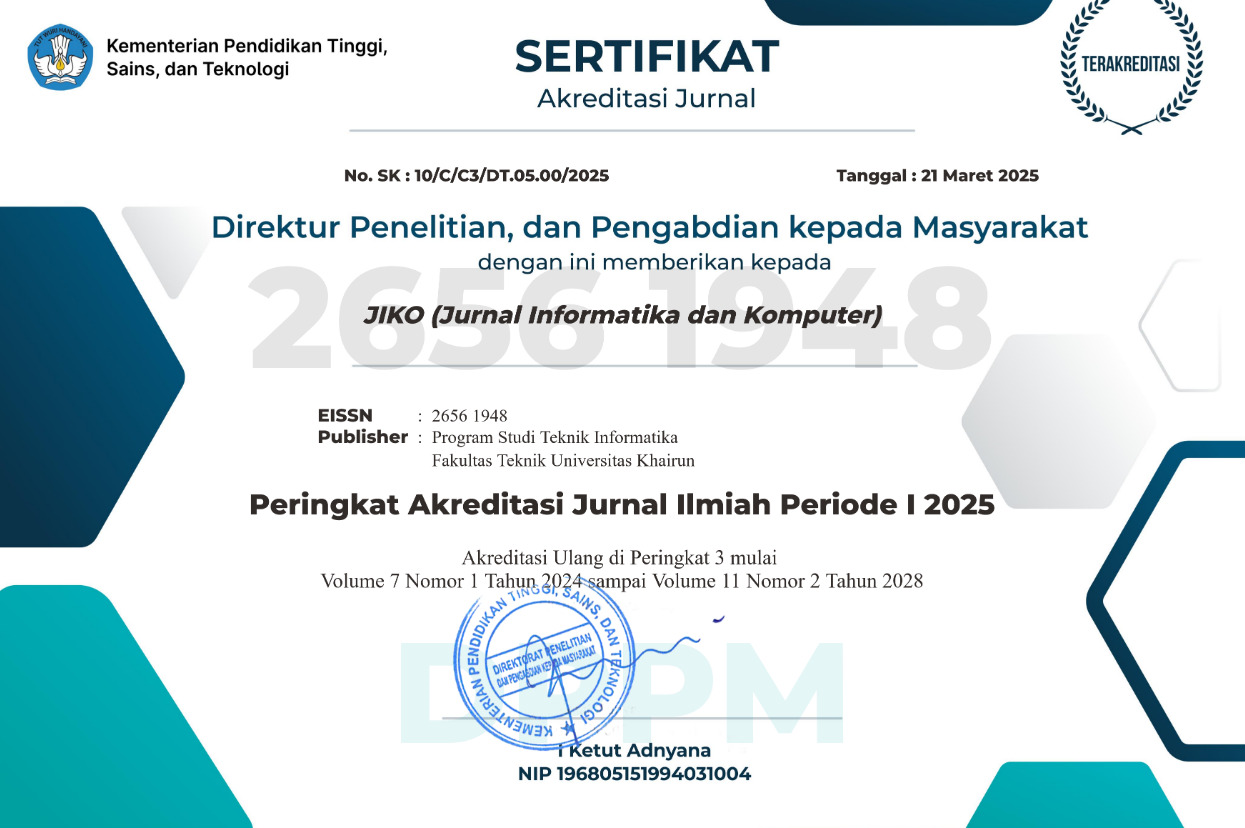APPLICATION OF SUPPORT VECTOR MACHINE ALGORITHM FOR STUDENTS' FINAL ASSIGNMENT STRESS CLASSIFICATION
Abstract
Full Text:
PDFReferences
U. Rusmawan, Teknik penulisan tugas akhir dan skripsi pemrograman. Elex media komputindo, 2019.
M. Wibowo and M. R. F. Djafar, “Perbandingan Metode Klasifikasi Untuk Deteksi Stress Pada Mahasiswa di Perguruan Tinggi,†Jurnal Media Informatika Budidarma, vol. 7, no. 1, pp. 153–159, 2023.
T. M. Wijiasih, R. N. S. Amriza, and D. A. Prabowo, “The Classification of Anxiety, Depression, and Stress on Facebook Users Using the Support Vector Machine,†JISA(Jurnal Informatika dan Sains), vol. 5, no. 1, pp. 75–79, 2022, doi: 10.31326/jisa.v5i1.1273.
S. B. Seto, M. T. S. Wondo, and M. F. Mei, “Hubungan Motivasi Terhadap Tingkat Stress Mahasiswa Dalam Menulis Tugas Akhir,†Jurnal Basicedu, vol. 4, no. 3, pp. 733–739, 2020.
S. Aulia and R. U. Panjaitan, “Kesejahteraan psikologis dan tingkat stres pada mahasiswa tingkat akhir,†Jurnal keperawatan jiwa, vol. 7, no. 2, p. 127, 2019.
M. Kang, S. Shin, G. Zhang, J. Jung, and Y. T. Kim, “Mental stress classification based on a support vector machine and naive Bayes using electrocardiogram signals,†Sensors, vol. 21, no. 23, p. 7916, 2021.
S. Aulia and R. U. Panjaitan, “Kesejahteraan psikologis dan tingkat stres pada mahasiswa tingkat akhir,†Jurnal keperawatan jiwa, vol. 7, no. 2, p. 127, 2019.
N. Khatape, P. Lad, S. Pawar, T. Sonawane, and K. R. Pathak, “Stress detection system using the SVM algorithm,†Journal of Advances in Computational Intelligence Theory, vol. 3, no. 1, 2021.
S. Muawanah, U. Muzayanah, M. G. R. Pandin, M. D. S. Alam, and J. P. N. Trisnaningtyas, “Stress and Coping Strategies of Madrasah’s Teachers on Applying Distance Learning During COVID-19 Pandemic in Indonesia,†Qubahan Academic Journal, vol. 3, no. 4, pp. 206–218, 2023, doi: 10.48161/Issn.2709-8206.
A. S. Rahayu, A. Fauzi, and R. Rahmat, “Komparasi Algoritma Naïve Bayes Dan Support Vector Machine (SVM) Pada Analisis Sentimen Spotify,†Jurnal Sistem Komputer dan Informatika (JSON), vol. 4, no. 2, p. 349, 2022, doi: 10.30865/json.v4i2.5398.
B. P. Tomasouw and F. Y. Rumlawang, “Penerapan Metode SVM Untuk Deteksi Dini Penyakit Stroke (Studi Kasus: RSUD Dr. H. Ishak Umarella Maluku Tengah dan RS Sumber Hidup-GPM),†Tensor: Pure and Applied Mathematics Journal, vol. 4, no. 1, pp. 37–44, 2023.
B. Sugara and A. Subekti, “Penerapan Support Vector Machine (Svm) Pada Small Dataset Untuk Deteksi Dini Gangguan Autisme,†Jurnal Pilar Nusa Mandiri, vol. 15, no. 2, pp. 177–182, 2019.
F. Pradana, F. A. Bachtiar, and M. Zulfikarrahman, “Implementasi Support Vector Machine untuk Deteksi Stres pada Pengguna E-Learning,†Jurnal Teknologi Informasi dan Ilmu Komputer, vol. 8, no. 4, pp. 763–768, 2021.
I. Zulfahmi, H. Syahputra, S. I. Naibaho, M. A. Maulana, and E. P. Sinaga, “Perbandingan Algoritma Support Vector Machine (SVM) dan Decision Tree Untuk Deteksi Tingkat Depresi Mahasiswa,†BINA INSANI ICT JOURNAL, vol. 10, no. 1, pp. 52–61, 2023.
R. Damasela, B. P. Tomasouw, and Z. A. Leleury, “Penerapan Metode Support Vector Machine (SVM) Untuk Mendeteksi Penyalahgunaan Narkoba,†PARAMETER: Jurnal Matematika, Statistika Dan Terapannya, vol. 1, no. 2, pp. 111–122, 2022.
DOI: https://doi.org/10.33387/jiko.v7i2.8618
Refbacks
- There are currently no refbacks.











